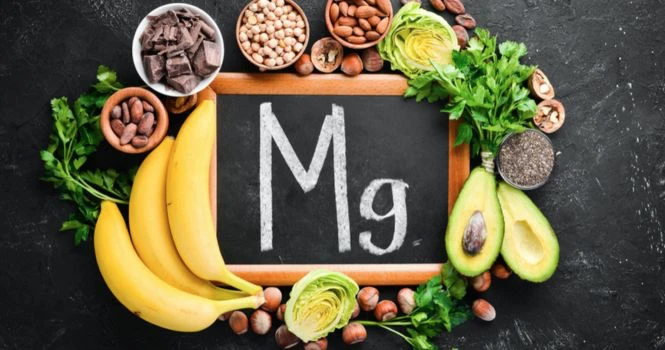We normally won’t hear or read about Magnesium rich foods. Let’s see what role has this mineral Magnesium or Mg, got to play in our daily lives.
Magnesium is the fourth most abundant mineral in the human body. The others are
- Calcium
- Phosphorus
- Potassium
Where is Magnesium Found in the Human Body?
Magnesium, an essential mineral, is found throughout the human body, with approximately 50-60% of total magnesium stored in bones. The remaining magnesium is distributed within cells, tissues, and organs, with only about 1% present in blood serum.
Intracellular magnesium is crucial for numerous enzymatic reactions and cellular processes, playing a vital role in energy production, protein synthesis, and cell growth and replication. Magnesium is also necessary for proper muscle and nerve function, contributing to healthy contractions and nerve signaling.
Extracellular magnesium, found in blood serum and interstitial fluid, is essential for regulating blood pressure, blood clotting, and maintaining proper nerve function. It is also involved in calcium homeostasis and bone mineralization.
The distribution of magnesium in the body highlights its diverse and critical roles in maintaining overall health. It is essential to maintain optimal magnesium levels through a balanced diet or supplementation to support the proper functioning of various physiological processes.
Is Magnesium required by our body?
Yes, magnesium is an essential mineral required by our body for maintaining optimal health. It plays a critical role in various physiological processes and is necessary for more than 300 enzymatic reactions. Some of the key functions of magnesium include:
1. Energy production: Magnesium is vital for the production of adenosine triphosphate (ATP), the primary source of energy for our cells.
2. Muscle and nerve function: Magnesium is crucial for proper muscle contractions and nerve signaling, which help maintain normal muscle and nerve function.
3. Bone health: Magnesium contributes to the structural development of bones and works alongside calcium to maintain bone density and prevent conditions like osteoporosis.
4. DNA and RNA synthesis: Magnesium is involved in the synthesis of nucleic acids, including DNA and RNA, which are essential for cell growth, replication, and repair.
5. Electrolyte balance: As an electrolyte, magnesium helps regulate the balance of fluids in the body and supports proper nerve and muscle function.
6. Blood sugar control: Magnesium plays a role in insulin function and glucose metabolism, helping to regulate blood sugar levels.
7. Blood pressure regulation: Magnesium helps to maintain healthy blood pressure by relaxing blood vessels and promoting a healthy balance of electrolytes.
8. Antioxidant production: Magnesium is involved in the synthesis of glutathione, a powerful antioxidant that helps protect cells from damage caused by free radicals.
Because our body cannot produce magnesium on its own, it is crucial to obtain an adequate amount of this essential mineral through diet or supplementation as needed.
How Much Magnesium Do You Need Everyday?
The recommended daily intake of magnesium varies depending on factors like age, sex, and life stage. Here are the general guidelines for daily magnesium requirements according to the National Institutes of Health (NIH):
Adults:
1. Men:
- Ages 19-30: 400 mg/day
- Ages 31 and older: 420 mg/day
2. Women:
- Ages 19-30: 310 mg/day
- Ages 31 and older: 320 mg/day
3. Pregnant Women:
- Ages 19-30: 350 mg/day
- Ages 31-50: 360 mg/day
4. Lactating Women:
- Ages 19-30: 310 mg/day
- Ages 31-50: 320 mg/day
5. Children and Adolescents:
- Ages 9-13: 240 mg/day
- Ages 14-18 (boys): 410 mg/day
- Ages 14-18 (girls): 360 mg/day
Please note that these are general guidelines and individual magnesium requirements may vary depending on factors like overall health, medical conditions, and activity levels. It’s important to consult with a healthcare professional to determine the appropriate daily magnesium intake for your specific needs.
What happens due to Magnesium Deficiency?
Magnesium deficiency, or hypomagnesemia, can lead to a range of adverse health effects due to magnesium’s involvement in numerous physiological processes. When magnesium levels are insufficient, several bodily functions may be disrupted, leading to various symptoms and potential complications. Some consequences of magnesium deficiency include:
1. Muscle cramps and spasms: Magnesium plays a critical role in muscle function and nerve signaling, so a deficiency can result in involuntary muscle contractions and pain.
2. Fatigue and weakness: Magnesium is essential for energy production at the cellular level. A deficiency can lead to a general feeling of fatigue and muscle weakness.
3. Numbness and tingling: Impaired nerve function due to magnesium deficiency can cause sensations of numbness and tingling, particularly in the extremities.
4. Heart palpitations and arrhythmias: Magnesium is important for maintaining a healthy heartbeat. A deficiency can cause irregular heart rhythms and palpitations.
5. Anxiety and mood disorders: Magnesium is involved in regulating neurotransmitters that influence mood and stress response. A deficiency can contribute to anxiety, depression, irritability, and other mood disorders.
6. Osteoporosis: Prolonged magnesium deficiency can lead to weakened bones and an increased risk of osteoporosis, as magnesium is essential for bone health and calcium regulation.
7. High blood pressure and cardiovascular issues: Magnesium helps regulate blood pressure. A deficiency can contribute to hypertension and increase the risk of heart disease and stroke.
8. Insulin resistance and type 2 diabetes: Magnesium is important for glucose metabolism. Low magnesium levels have been linked to insulin resistance and an increased risk of developing type 2 diabetes.
9. Migraines and headaches: Some studies suggest that people who suffer from migraines may have lower magnesium levels, and magnesium deficiency can contribute to tension headaches.
Addressing magnesium deficiency through dietary changes, supplementation, or other interventions under the guidance of a healthcare professional is essential to prevent these potential complications and maintain overall health.
List of Magnesium Rich Foods

Incorporating magnesium-rich foods into your diet is a great way to ensure adequate magnesium intake and maintain overall health. Here are the top 10 magnesium-packed foods:
1. Dark leafy greens:
Spinach, Swiss chard, and kale are excellent sources of magnesium, along with other essential nutrients like vitamins A, C, and K.
2. Nuts and seeds:
Almonds, cashews, Brazil nuts, and pumpkin seeds are packed with magnesium. Other nuts and seeds, such as walnuts, sunflower seeds, and flaxseeds, also contain good amounts of magnesium.
3. Legumes:
Beans, lentils, chickpeas, and peas are rich in magnesium and provide an excellent source of plant-based protein and fiber.
4. Whole grains:
Brown rice, quinoa, bulgur, barley, and oats are whole grains that contain significant amounts of magnesium, as well as other essential nutrients like fiber, B vitamins, and minerals.
5. Dark chocolate:
High-quality dark chocolate with a high cocoa content (70% or more) is not only a delicious treat but also a good source of magnesium and antioxidants.
6. Avocado:
This nutrient-dense fruit is rich in magnesium, healthy monounsaturated fats, fiber, vitamins, and other minerals.
7. Bananas:
While bananas are well-known for their potassium content, they also provide a decent amount of magnesium, making them a nutritious snack option.
8. Fish:
Fatty fish such as salmon, mackerel, and halibut contain considerable amounts of magnesium, along with omega-3 fatty acids and high-quality protein.
9. Tofu:
Made from soybeans, tofu is an excellent source of magnesium, plant-based protein, and other essential nutrients like calcium and iron.
10. Yogurt:
Low-fat or non-fat plain yogurt is a good source of magnesium, as well as calcium, protein, and probiotics that support digestive health.
Including a variety of these magnesium-rich foods in your daily diet can help ensure you meet your body’s magnesium requirements and promote overall health.
List of 21 Magnesium Rich Foods from 10 Broad Sources
| Food | Magnesium Content (mg) | Serving Size |
| Pumpkin Seeds | 156 | 1 ounce (28 grams) |
| Brazil Nuts | 107 | 1 ounce (28 grams) |
| Almonds | 80 | 1 ounce (28 grams) |
| Spinach | 78 | 1/2 cup cooked (90 grams) |
| Swiss Chard | 75 | 1/2 cup cooked (88 grams) |
| Dark Chocolate | 64 | 1 ounce (28 grams) |
| Black Beans | 60 | 1/2 cup cooked (86 grams) |
| Quinoa | 58 | 1/4 cup uncooked (43 grams) |
| Halibut | 48 | 3 ounces (85 grams) |
| Avocado | 39 | 1 medium (150 grams) |
| Cashews | 74 | 1 ounce (28 grams) |
| Kale | 47 | 1/2 cup cooked (67 grams) |
| Lentils | 36 | 1/2 cup cooked (100 grams) |
| Brown Rice | 42 | 1/2 cup cooked (125 grams) |
| Oats | 58 | 1/2 cup uncooked (40 grams) |
| Mackerel | 65 | 3 ounces (85 grams) |
| Edamame | 50 | 1/2 cup cooked (93 grams) |
| Sunflower Seeds | 37 | 1 ounce (28 grams) |
| Buckwheat | 65 | 1/4 cup uncooked (45 grams) |
| Bananas | 32 | 1 medium (118 grams) |
| Plain Low-fat Yogurt | 30 | 1 cup (245 grams) |
Frequently Asked Questions
What foods are highest in Magnesium?
Pumpkin seeds, Brazil nuts, almonds, spinach, Swiss chard, dark chocolate, black beans, quinoa, halibut, and avocado.
What fruit is highest in Magnesium?
Avocado is considered a fruit and has the highest magnesium content among fruits. Bananas are also a good source of magnesium.
Which fruit has Magnesium?
Avocado, bananas, figs, and papayas are some examples of fruits containing magnesium.
What are the top 10 vegetables highest in Magnesium?
Spinach, Swiss chard, kale, beet greens, collard greens, broccoli, Brussels sprouts, artichokes, mustard greens, and turnip greens.
How can I get 100% Magnesium daily?
Consume a balanced diet rich in magnesium-containing foods, including nuts, seeds, whole grains, legumes, dark leafy greens, and fish. Consult with a healthcare professional to determine your specific daily magnesium requirements and consider supplementation if needed.
How can I raise my Magnesium quickly?
Increase your intake of magnesium-rich foods, consider using a high-quality magnesium supplement, and consult with a healthcare professional for personalized guidance.
Are apples rich in Magnesium?
Apples contain a small amount of magnesium, but they are not considered a rich source of the mineral.
Is Papaya high in Magnesium?
Papaya contains a moderate amount of magnesium, contributing to a healthy diet but not considered a high source of magnesium.
Which nuts are high in Magnesium?
Brazil nuts, almonds, and cashews are among the nuts with the highest magnesium content.
What kind of Magnesium is best?
The best form of magnesium depends on individual needs and preferences. Common forms include magnesium citrate, magnesium glycinate, and magnesium oxide. Consult your Doctor to determine the most suitable form for your specific needs.
What are the 10 signs of Low Magnesium?
Muscle cramps and spasms, fatigue and weakness, numbness and tingling, heart palpitations and arrhythmias, anxiety and mood disorders, osteoporosis, high blood pressure, insulin resistance and type 2 diabetes, migraines and headaches, and poor nail health.
What drinks have Magnesium?
Some beverages that contain magnesium include mineral water, milk, fortified plant-based milk alternatives (e.g., almond milk), and certain smoothies made with magnesium-rich fruits, vegetables, or seeds.
Magnesium in Banana
A medium-sized banana (118 grams) contains approximately 32 mg of magnesium.
Magnesium in Almonds
A 1-ounce serving of almonds (28 grams) provides approximately 80 mg of magnesium.










